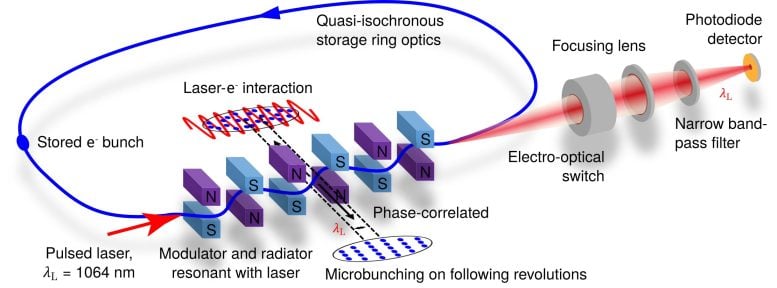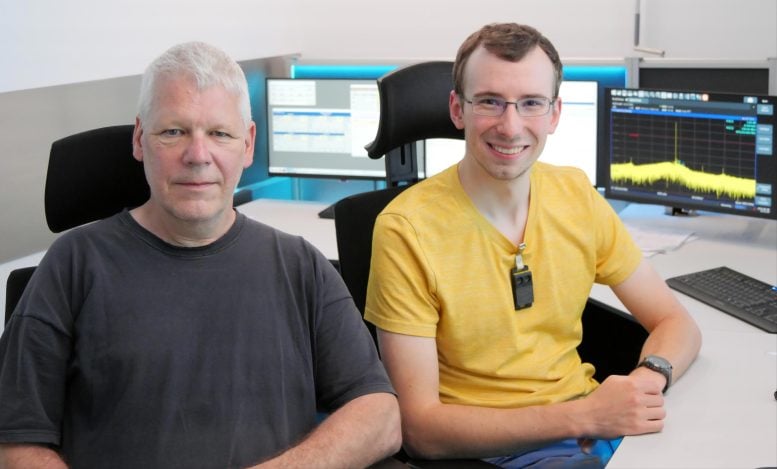
A new technique shortens electron bunches in storage rings to produce more powerful, coherent synchrotron radiation, akin to high-power lasers. This method has been successfully tested, marking progress toward a novel type of radiation source that could have significant impacts on materials research.
An international team presents the functional principle of a new source of synchrotron radiation in Nature Communications Physics. Steady-state microbunching (SSMB) enables the building efficient and powerful radiation sources for coherent UV radiation in the future. This is very attractive for applications in basic research as well in the semiconductor industry.
Synchrotron Radiation and Storage Rings
When ultrafast electrons are deflected, they emit light-synchrotron radiation. This is used in so-called storage rings in which magnets force the particles onto a closed path. This light is longitudinally incoherent and consists of a broad spectrum of wavelengths. Its high brilliance makes it an excellent tool for materials research. Monochromators can be used to pick out individual wavelengths from the spectrum, but this reduces the radiant power by many orders of magnitude to values of a few watts only.

Advancements in Coherent Light Generation
But what if a storage ring were instead to deliver monochromatic, coherent light with outputs of several kilowatts, analogous to a high-power laser? Physicist Alexander Chao and his doctoral student Daniel Ratner found an answer to this challenge in 2010: if the electron bunches orbiting in a storage ring become shorter than the wavelength of the light they emit, the emitted radiation becomes coherent and therefore millions of times more powerful.
“You need to know that the electrons in a storage ring are not homogeneously distributed,” explains Arnold Kruschinski, PhD student at HZB and lead author of the paper. “They move in bunches with a typical length of about a centimeter and a distance of around 60 centimeters. That is six orders of magnitude more than the micro-bunches proposed by Alexander Chao.” Chinese theorist Xiujie Deng has defined a set of settings for a specific type of circular accelerator, the isochrone or “low-alpha” rings, for the Steady-State Micro-Bunching project (SSMB). After interacting with a laser, these create short particle bunches that are only one micrometer long.
Breakthroughs in Micro-Bunching Techniques
The research team from HZB, Tsinghua University, and PTB already demonstrated that this works in a proof-of-principle experiment in 2021. They used the Metrology Light Source (MLS) in Adlershof — the first storage ring ever designed for low-alpha operation. The team has now been able to fully verify Deng’s theory for generating micro-bunches in extensive experiments. “For us, this is an important step on the way to a new type of SSMB radiation source,” says Arnold Kruschinski.

Future Perspectives and Long-Term Goals
However, HZB project manager Jörg Feikes is certain that it will take some time until then. He sees some parallels between the SSMB and the development of free-electron lasers. “After initial experiments and decades of development work, this idea turned into a kilometer-long, superconducting accelerator,” he says. “Such developments are very long-term. It starts with an idea, then a theory, and then there are experimenters who gradually realise it and I think that SSMB will develop in the same way.”
Reference: “Confirming the theoretical foundation of steady-state microbunching” by Arnold Kruschinski, Xiujie Deng, Jörg Feikes, Arne Hoehl, Roman Klein, Ji Li, Markus Ries and Alexander Chao, 21 May 2024, Communications Physics.
DOI: 10.1038/s42005-024-01657-y
1 Comment
A new technique shortens electron bunches in storage rings to produce more powerful, coherent synchrotron radiation, akin to high-power lasers. It starts with an idea, then a theory, and then there are experimenters who gradually realise it.
VERY GOOD!
The synchronous effect of topological vortices has always dominated the evolution of all things in the universe.
The rotation of topological vortices is spin. Spin generates gravitation. Spin generates energy. Spin generates evolution. Their interaction via synchronous effect is very interesting. Their superposition includes both logical superposition in space-time and factual superposition in reality. Their entanglement includes both surface entanglement and body entanglement. Their deflection methods are endless. In the interaction and balance of topological vortex fractal structures, spin creates everything in the world.
The universe does not make algebra, formulas, or fractions. The universe is a superposition, deflection, and entanglement of geometric shapes, is the interaction and balance of countless topological vortex fractal structures. In these interaction and balance, the past is difficult to change. For the future, some predictable, some unpredictable. But, the present moment is real, certain, and actionable. Physics should not ignore that low dimensional topological fractal structures are the material basis of high-dimensional spacetime.
Scientific research guided by correct theories can help humanity avoid detours, failures, and pomposity. Please witness the exemplary collaboration between theoretical physicists and experimentalists (https://scitechdaily.com/microscope-spacecrafts-most-precise-test-of-key-component-of-the-theory-of-general-relativity/#comment-854286). Some people in contemporary physics has always lived in a self righteous children’s story world. Whose values have been overturned by such a comical and ridiculous reality?
Misguided by the pseudo-scientific theory of Physical Review Letters (PRL), many researchers do not consider the similarities and differences between geometric shapes and physical reality in physics research, but indulge in imagination, and some scholars’ physics research seriously deviates from science, and they are almost unaware of the dirtiness and ugliness. Although mathematics is the language of science, it must be understood correctly.
I hope researchers are not fooled by the pseudoscientific theories of the Physical Review Letters (PRL), and hope more people dare to stand up and fight against rampant pseudoscience.
The so-called academic journals (such as Physical Review Letters, Nature, Science, etc.) firmly believe that two high-dimensional spacetime objects (such as two sets of cobalt-60) rotating in opposite directions can be transformed into two objects that mirror each other, is a typical case of pseudoscience rampant.
Scientific research should be respected, but some people in contemporary physics are not. Please witness the actions of certain individuals and publications. If researchers are really interested in Science and Physics, you can browse https://zhuanlan.zhihu.com/p/643404671 and https://zhuanlan.zhihu.com/p/595280873.
The Physical Review journals, encompassing both hybrid and open-access journals, features 17 peer-reviewed publications including Physical Review Letters, Physical Review X, and Reviews of Modern Physics. CP violation was published in Physics Review in 1956. All so-called peer-reviewed publications of Physical Review family are responsible for clarifying this.
CP violation opened the dirtiest and ugliest era in the history of physics.